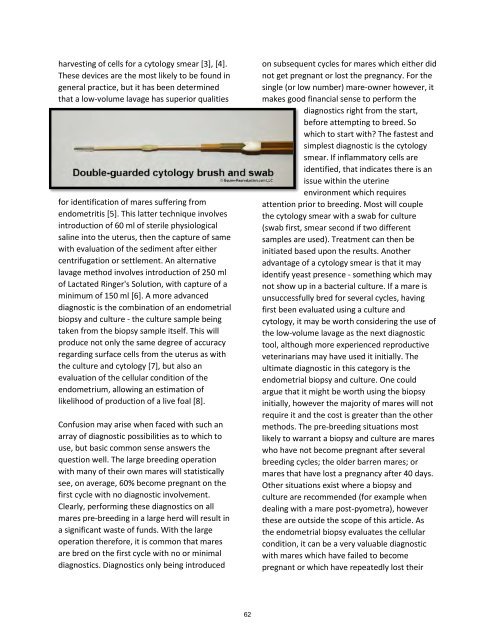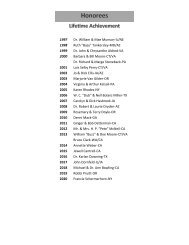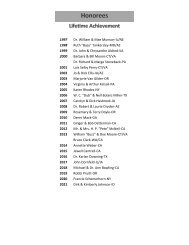Arabian Sport Horse Alliance 2017-2018 Directory & Yearbook
Annual publication of the Arabian Sport Horse Alliance, Inc. Honoree Articles, Award Listings, Photo Galleries, Youth Member Spotlights, Stallion Pages, Farm Profiles, Educational Articles, and more.....
Annual publication of the Arabian Sport Horse Alliance, Inc.
Honoree Articles, Award Listings, Photo Galleries, Youth Member Spotlights, Stallion Pages, Farm Profiles, Educational Articles, and more.....
Create successful ePaper yourself
Turn your PDF publications into a flip-book with our unique Google optimized e-Paper software.
harvesting of cells for a cytology smear [3], [4].<br />
These devices are the most likely to be found in<br />
general practice, but it has been determined<br />
that a low-volume lavage has superior qualities<br />
for identification of mares suffering from<br />
endometritis [5]. This latter technique involves<br />
introduction of 60 ml of sterile physiological<br />
saline into the uterus, then the capture of same<br />
with evaluation of the sediment after either<br />
centrifugation or settlement. An alternative<br />
lavage method involves introduction of 250 ml<br />
of Lactated Ringer's Solution, with capture of a<br />
minimum of 150 ml [6]. A more advanced<br />
diagnostic is the combination of an endometrial<br />
biopsy and culture - the culture sample being<br />
taken from the biopsy sample itself. This will<br />
produce not only the same degree of accuracy<br />
regarding surface cells from the uterus as with<br />
the culture and cytology [7], but also an<br />
evaluation of the cellular condition of the<br />
endometrium, allowing an estimation of<br />
likelihood of production of a live foal [8].<br />
Confusion may arise when faced with such an<br />
array of diagnostic possibilities as to which to<br />
use, but basic common sense answers the<br />
question well. The large breeding operation<br />
with many of their own mares will statistically<br />
see, on average, 60% become pregnant on the<br />
first cycle with no diagnostic involvement.<br />
Clearly, performing these diagnostics on all<br />
mares pre-breeding in a large herd will result in<br />
a significant waste of funds. With the large<br />
operation therefore, it is common that mares<br />
are bred on the first cycle with no or minimal<br />
diagnostics. Diagnostics only being introduced<br />
on subsequent cycles for mares which either did<br />
not get pregnant or lost the pregnancy. For the<br />
single (or low number) mare-owner however, it<br />
makes good financial sense to perform the<br />
diagnostics right from the start,<br />
before attempting to breed. So<br />
which to start with? The fastest and<br />
simplest diagnostic is the cytology<br />
smear. If inflammatory cells are<br />
identified, that indicates there is an<br />
issue within the uterine<br />
environment which requires<br />
attention prior to breeding. Most will couple<br />
the cytology smear with a swab for culture<br />
(swab first, smear second if two different<br />
samples are used). Treatment can then be<br />
initiated based upon the results. Another<br />
advantage of a cytology smear is that it may<br />
identify yeast presence - something which may<br />
not show up in a bacterial culture. If a mare is<br />
unsuccessfully bred for several cycles, having<br />
first been evaluated using a culture and<br />
cytology, it may be worth considering the use of<br />
the low-volume lavage as the next diagnostic<br />
tool, although more experienced reproductive<br />
veterinarians may have used it initially. The<br />
ultimate diagnostic in this category is the<br />
endometrial biopsy and culture. One could<br />
argue that it might be worth using the biopsy<br />
initially, however the majority of mares will not<br />
require it and the cost is greater than the other<br />
methods. The pre-breeding situations most<br />
likely to warrant a biopsy and culture are mares<br />
who have not become pregnant after several<br />
breeding cycles; the older barren mares; or<br />
mares that have lost a pregnancy after 40 days.<br />
Other situations exist where a biopsy and<br />
culture are recommended (for example when<br />
dealing with a mare post-pyometra), however<br />
these are outside the scope of this article. As<br />
the endometrial biopsy evaluates the cellular<br />
condition, it can be a very valuable diagnostic<br />
with mares which have failed to become<br />
pregnant or which have repeatedly lost their<br />
62












